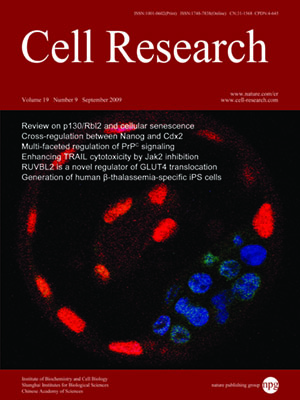
Volume 19, No 9, Sep 2009
ISSN: 1001-0602
EISSN: 1748-7838 2018
impact factor 17.848*
(Clarivate Analytics, 2019)
Volume 19 Issue 9, September 2009: 1052-1061
ORIGINAL ARTICLES
Cross-regulation of the Nanog and Cdx2 promoters
Lingyi Chen1,2,3,4,5, Akiko Yabuuchi1,2,3,4,5, Sarah Eminli6, Ayumu Takeuchi1,2,3,4,5, Chi-Wei Lu1,2,3,4,5, Konrad Hochedlinger6 and George Q Daley1,2,3,4,5
1Division of Pediatric Hematology/Oncology, Children's Hospital Boston and Dana Farber Cancer Institute, Boston, MA, USA
2Department of Biological Chemistry and Molecular Pharmacology, Harvard Medical School, Boston, MA, USA
3Division of Hematology, Brigham and Women's Hospital, Boston, MA, USA
4Harvard Stem Cell Institute, Boston, MA, USA
5Howard Hughes Medical Institute, Boston, MA, USA
6Massachusetts General Hospital Cancer Center and Center for Regenerative Medicine, Harvard Stem Cell Institute, Boston, MA, USA
Correspondence: George Q Daley,(george.daley@childrens.harvard.edu )
The first cell fate choice in the mammalian embryo, the segregation of the inner cell mass (ICM) and trophectoderm (TE), is regulated by the mutually antagonistic effects of the transcription factors, Oct4 and Cdx2, while the pluripotency factor, Nanog, is essential to specify the epiblast. We have analyzed the promoters of Nanog and Cdx2, and have found that these two transcription factors are likewise regulated reciprocally. Using an embryonic stem cell line with conditional TE differentiation, we show that Nanog overexpression suppresses the upregulation of TE markers, while Nanog knockdown upregulates the expression of TE markers. We further show that Nanog and Cdx2 bind to and repress each other's promoters. However, whereas Nanog knockout results in detectable Cdx2 expression in the ICM, we observe no overt disruption of blastocyst development, indicating that Nanog plays a subservient role to Oct4 in segregation of the ICM and TE.
Cell Research (2009) 19:1052-1061. doi: 10.1038/cr.2009.79 published online 30 June 2009
FULL TEXT | PDF
Browse 2002


